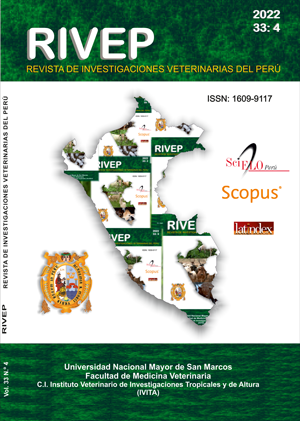Coproparasitological diagnosis of fascioliasis in sheep and goats from Boavita, Boyacá (Colombia)
DOI:
https://doi.org/10.15381/rivep.v33i4.23340Keywords:
flukes, sheep, goats, fascioliasisAbstract
The aim of this study was to establish the prevalence of Fasciola hepatica through coprological analysis and to identify risk factors associated with the presentation of the parasite in sheep and goats in the municipality of Boavita, Boyacá. The study was observational, descriptive, cross-sectional with simple random sampling. Faecal samples were taken from 297 sheep and 337 goats to identify parasite eggs. The general prevalence was 8.0% (51/634), being 9.1% for sheep and 7.1% for goats. The prevalence in sheep was higher in males (14.8%) than in females (8.5%), likewise, sheep less than one year old (9.3%) and Criolla (11.1%) presented the highest prevalence. In goats, the prevalence was higher in females (7.3%) than in males (5.6%), and those less than one year old (10.5%) and the Alpine breed (8%) presented the greater prevalence. No significant statistical association was found between females and males. The Creole breed was established as a risk factor for sheep.
Downloads
Downloads
Published
Issue
Section
License
Copyright (c) 2022 Melissa C. Ortiz-Pineda, Miguel E. López-Buitrago, Diana M. Bulla-Castañeda, Henrry A. Lopez-Buitrago, Deisy J. Lancheros-Buitrago, Adriana M. Díaz-Anaya, Julio C. Giraldo Forero, Diego J. Garcia-Corredor, Martín O. Pulido-Medellín

This work is licensed under a Creative Commons Attribution 4.0 International License.
AUTHORS RETAIN THEIR RIGHTS:
a. Authors retain their trade mark rights and patent, and also on any process or procedure described in the article.
b. Authors retain their right to share, copy, distribute, perform and publicly communicate their article (eg, to place their article in an institutional repository or publish it in a book), with an acknowledgment of its initial publication in the Revista de Investigaciones Veterinarias del Perú (RIVEP).
c. Authors retain theirs right to make a subsequent publication of their work, to use the article or any part thereof (eg a compilation of his papers, lecture notes, thesis, or a book), always indicating the source of publication (the originator of the work, journal, volume, number and date).



